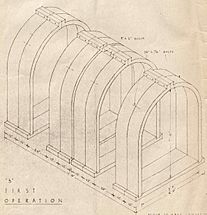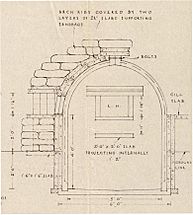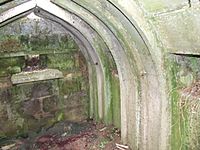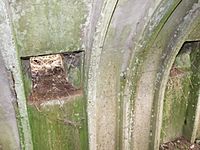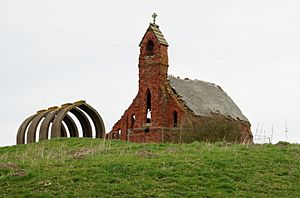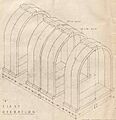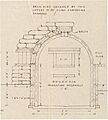Ruck machine gun post facts for kids
Quick facts for kids Ruck machine gun post |
|
|---|---|
| Deployed in Lincolnshire and along the east coast of England | |
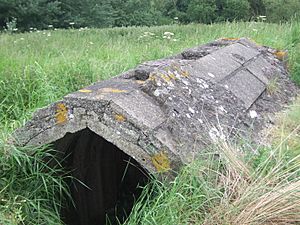
An example still standing at Lawyers' Creek, Holbeach. You can find it using this map reference: TF4002333744. The horizontal openings on one side are now partly buried and covered in plants. Notice the vertical openings too.
|
|
| Type | Pillbox |
| Site history | |
| In use | Second World War |
| Materials | Concrete |
The Ruck machine gun post, also called a Ruck pillbox, was a strong, small fort built in Britain. It was made during the Second World War when Britain was worried about being invaded.
This special fort was designed by a man named James Ruck. It was built using parts made ahead of time from concrete, along with paving slabs, sandbags, and packed-down earth. Ruck machine gun posts were used quite a lot in Lincolnshire and along the east coast of England. However, they are now very rare. Only a few examples still exist today.
How Was the Ruck Post Designed?
James Ruck worked for the government during the war. He helped build air-raid shelters to protect people from bombs. In June 1940, he came up with an idea for a new type of machine gun post. He told the military:
I propose they be constructed of hollow concrete blocks filled with the earth excavated from the site, roofed with precast concrete beams and paving stone flags; walls 18" thick, spaces being left in each side so that fire can be operated in any direction; a portion of the roof could also be adjustable for firing overhead.
Ruck's design used pre-made, half-arch concrete pieces. These were made by a company in Scunthorpe. Four of these 12-inch (about 30 cm) sections formed an arch. The inside of the arch was 5 feet (1.5 m) wide, 7 feet (2.1 m) high, and 2 feet (61 cm) long. Many arches could be put together to make a longer building.
For the Ruck post, 20-inch (51 cm) gaps were left between the arches. These gaps became the embrasures, which are openings for guns. The inside length of the post was about 12 feet (3.7 m). The arches were covered with two layers of mortar and concrete paving slabs. This filled in the gaps, except where the gun openings were needed. The walls ended up being 6 to 9 inches (15 to 23 cm) thick.
The ends of the post were built with hollow concrete blocks filled with bricks. One end had a gun opening, and the other end had an entrance. The concrete itself didn't offer a lot of protection. So, the post was partly buried in the ground. Then, an outer wall of sandbags was built around it, up to the level of the gun openings. The space between the sandbags and the concrete was filled with packed earth.
James Ruck was very keen on his design. He said the main good things about it were that it could be built quickly. Also, unskilled workers could build it. It didn't use many new materials. The pre-made parts could be made very fast, about 70 posts per day. Ruck claimed that six unskilled men could finish three posts in one day. He also pointed out that his design used "hundreds of thousands of tons" of material that was already available. This meant it didn't need new cement or steel. Ruck thought each post would only cost about £40.
Building and Disappearing Ruck Posts
In July 1940, orders were given to build 1,600 of these posts. By September 1940, about 4,000 posts had been built. There were even orders for 2,000 more.
Today, the Ruck machine gun post is a bit of a puzzle. Even though so many were built, it's hard to find them now. Only 5 were recorded by a project called "Defence of Britain." One reason they are rare is that Ruck posts were easy to take apart. Many of them might have been taken down after the war.
Because the posts had to be partly buried, they worked best on higher ground. Many might have been built on soft cliffs and sand dunes along the coast. Over time, the changing coastline and erosion could have washed them away. It's also possible that some still exist but people don't realize what they are.
Images for kids


